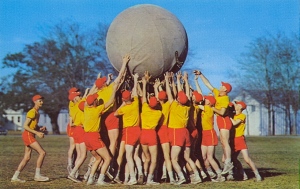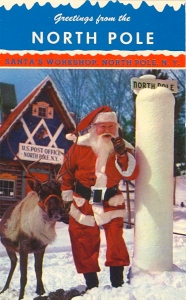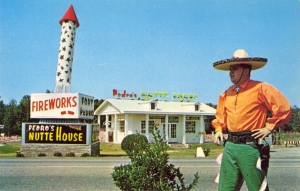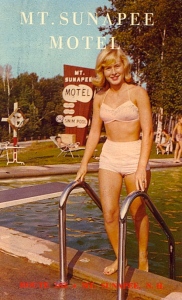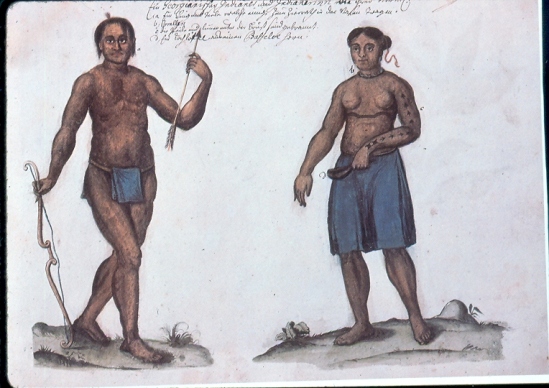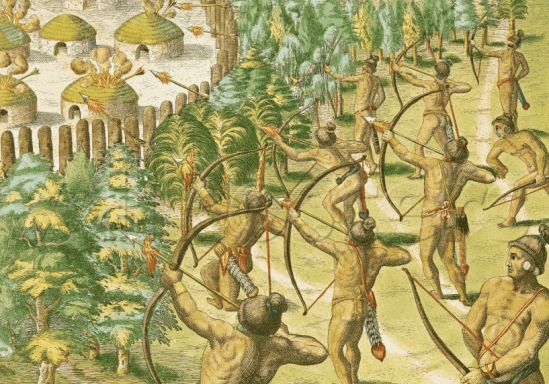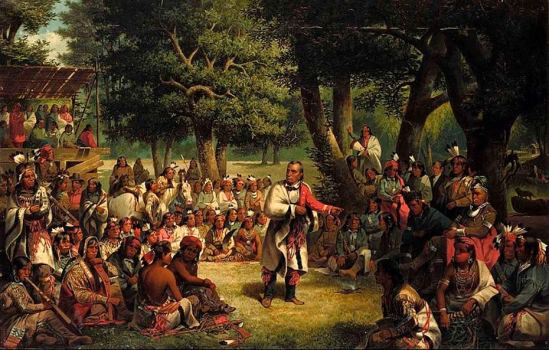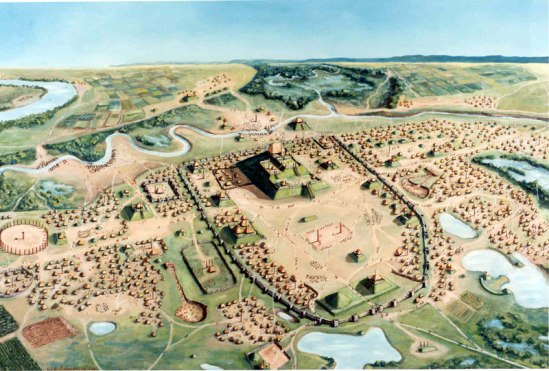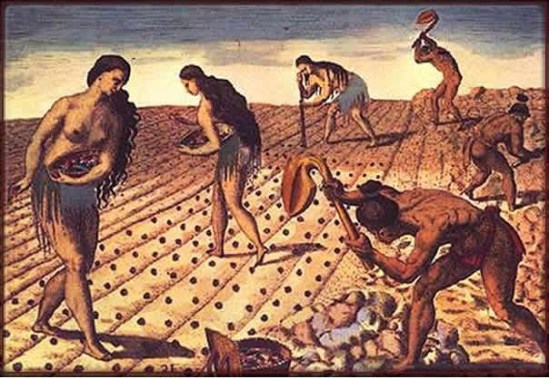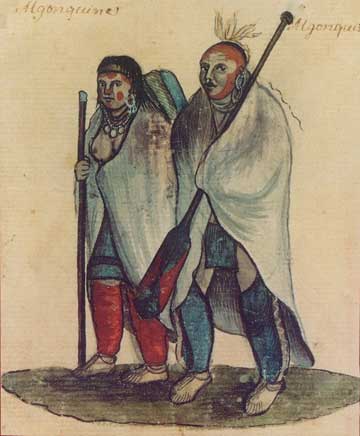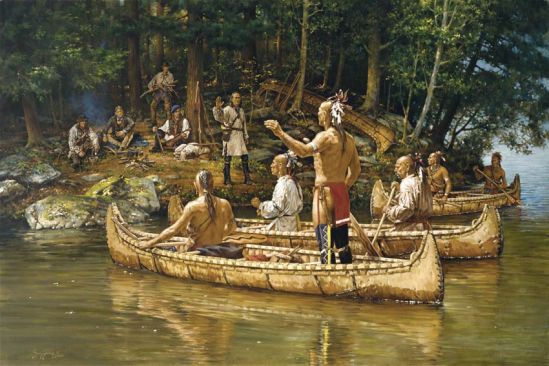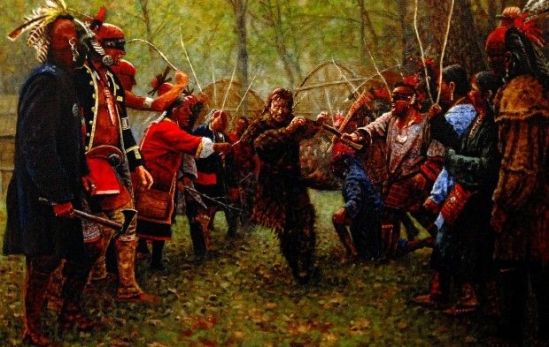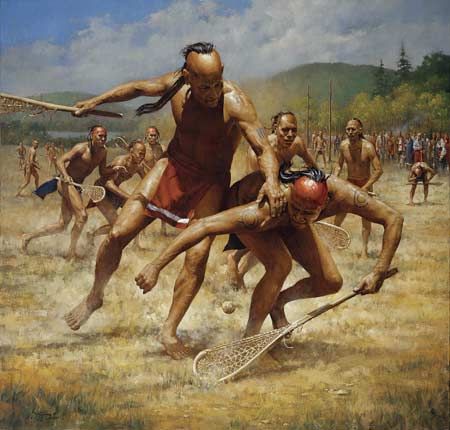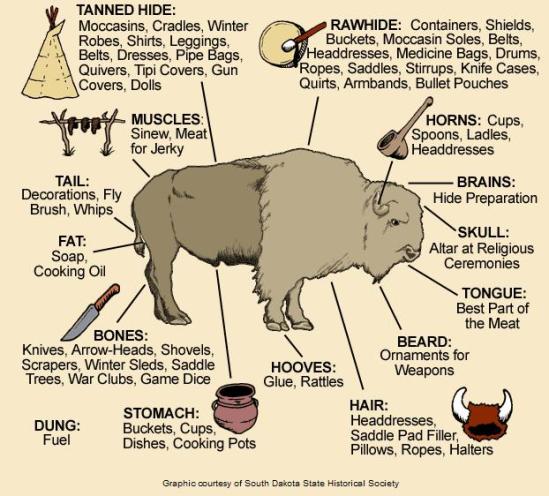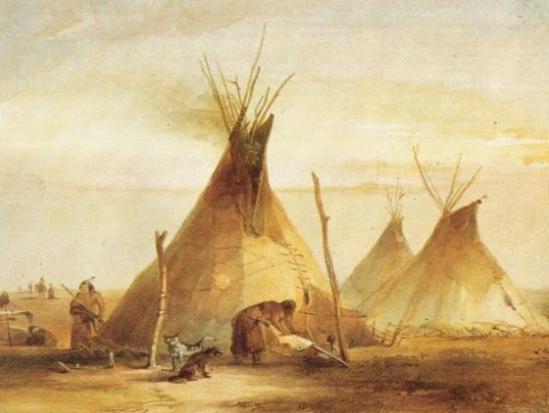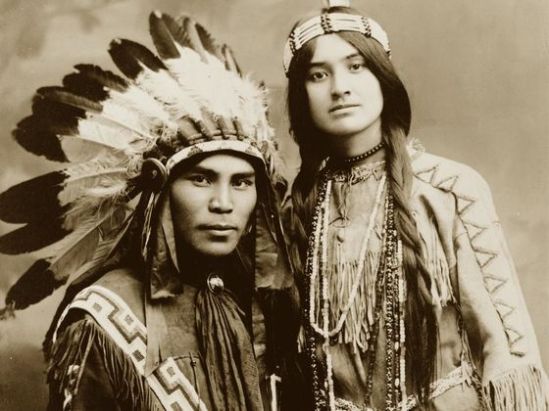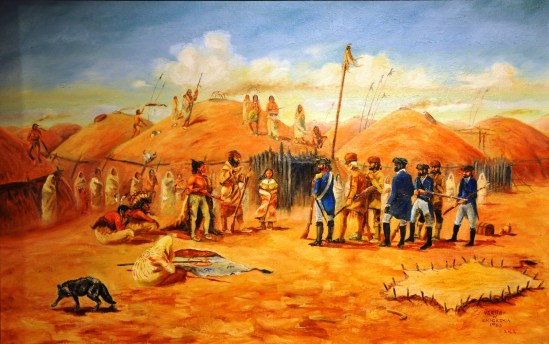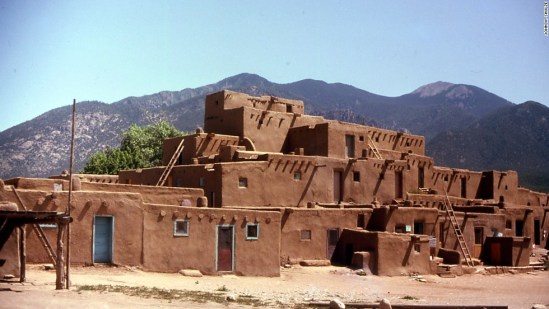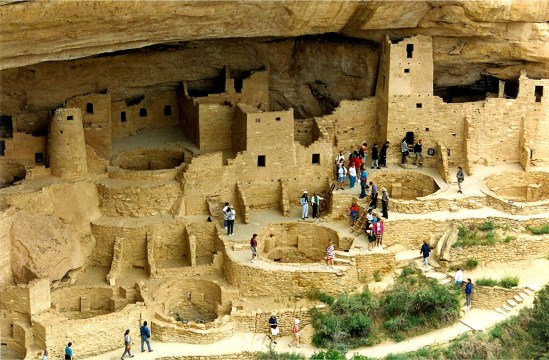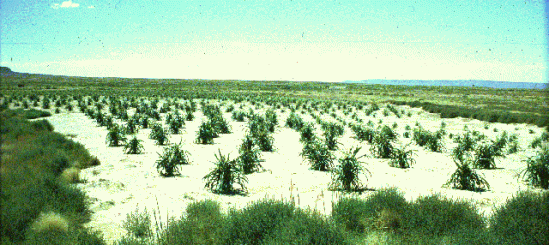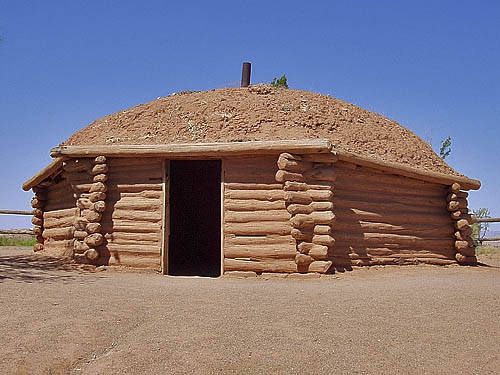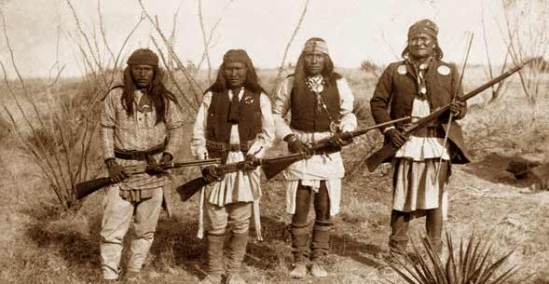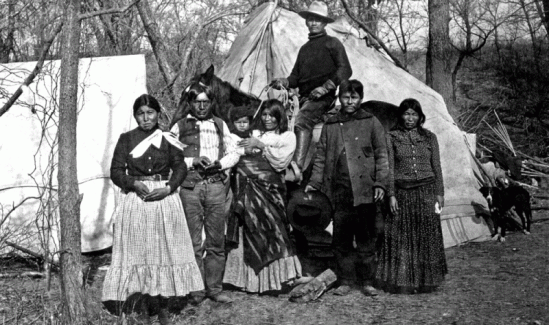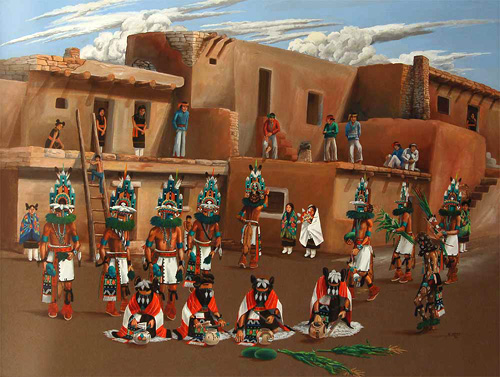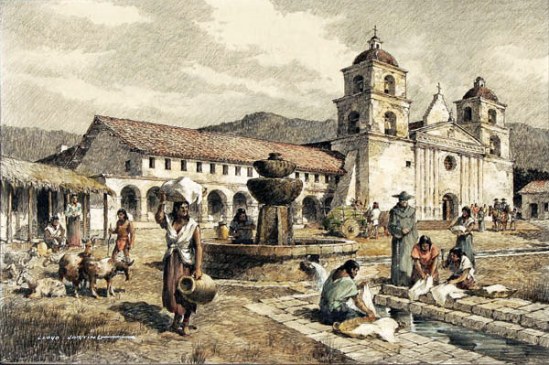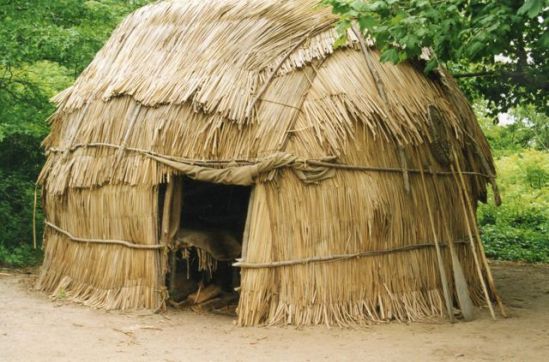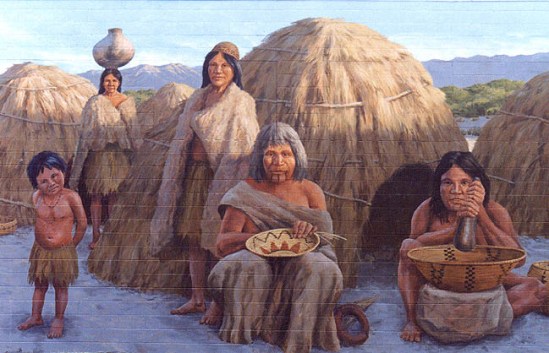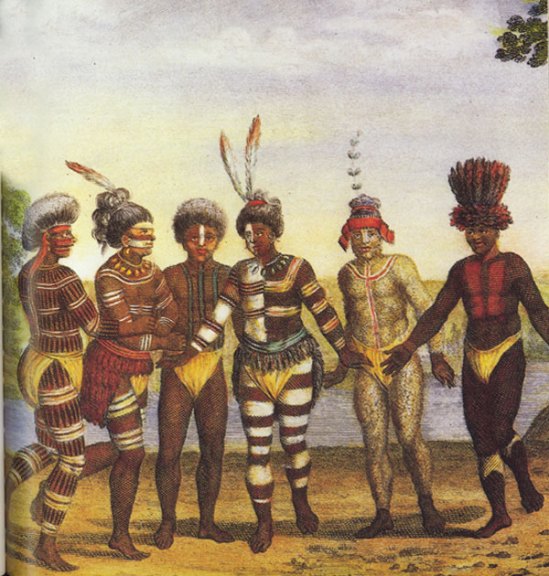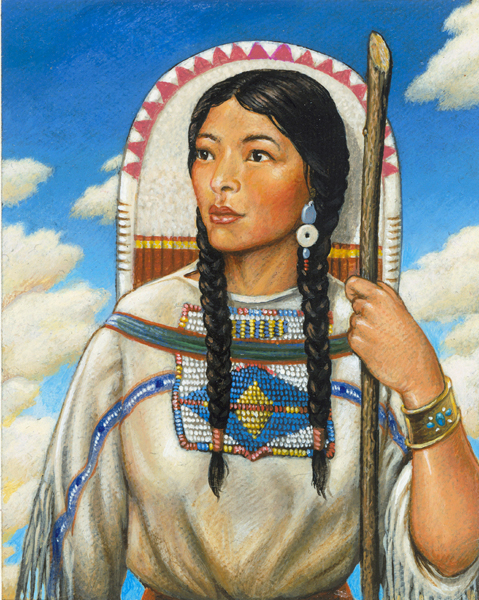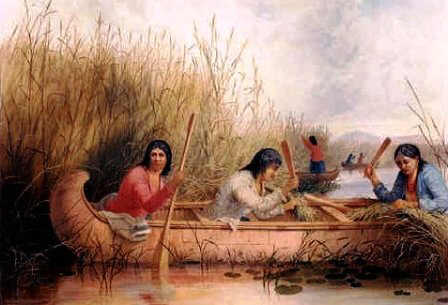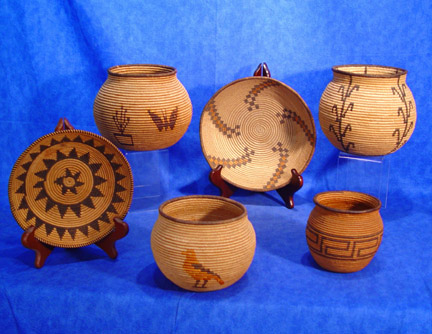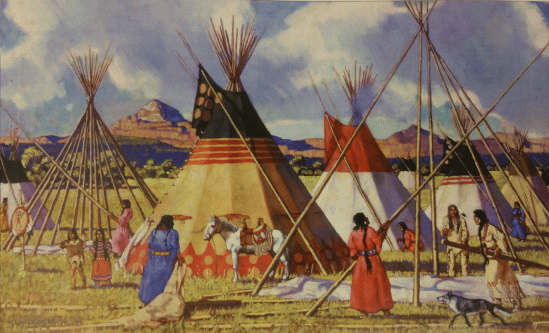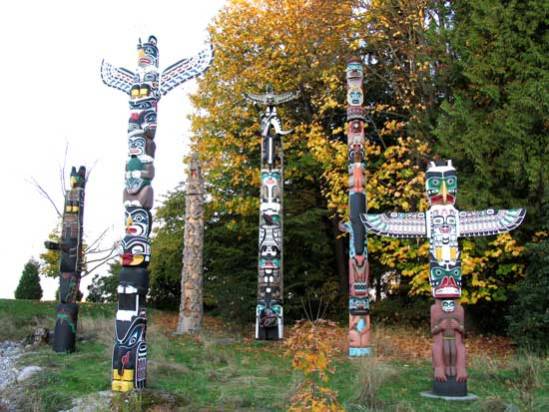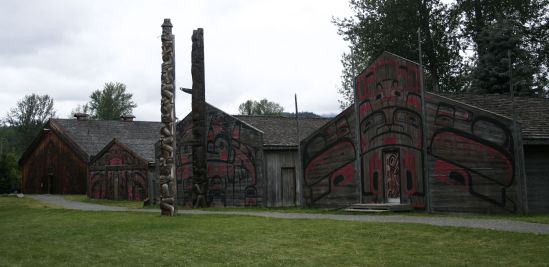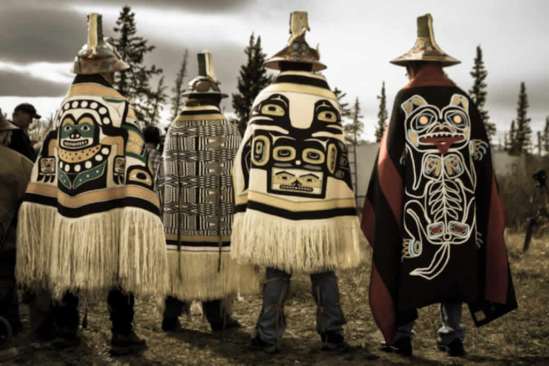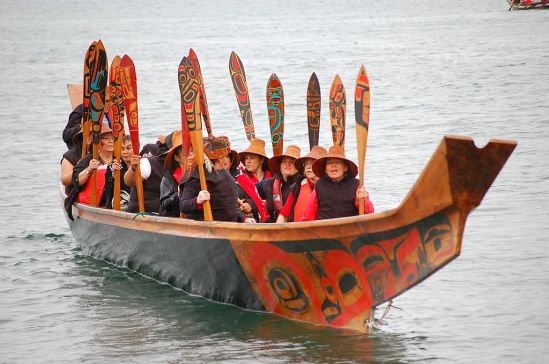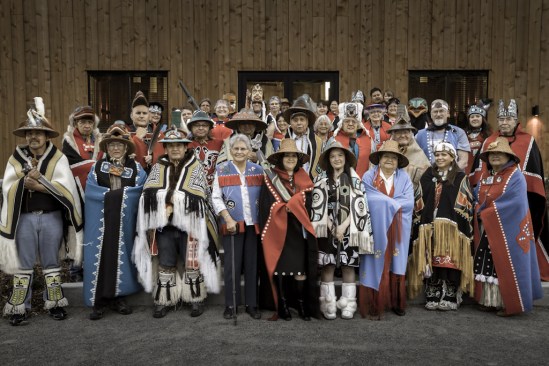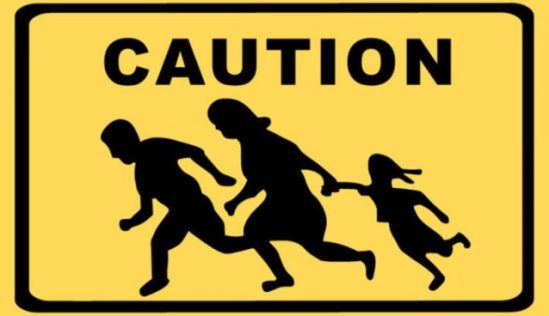
There are very few people in the United States who have been so unfairly exploited, marginalized, vilified, and scapegoated in political smear campaigns than the undocumented immigrants. These are people who have entered the country and reside there without any legal authorization. As of 2016, there are 11.3 million undocumented immigrants living among us throughout the nation. Many of them live in poverty and are vulnerable to exploitation as well as live in fear of their status being discovered, detained, and deported. Some of them came to the US as children and to them America is the only country they know. Many are parents of children who are US citizens and run a high risk of their families being torn apart. These are people whose lives are in limbo but all are human beings who deserve to be treated with dignity as well as contribute to this country. But they suffer immensely for their undocumented immigration status, are denied rights and services most Americans enjoy, have no path to legalization and citizenship, and live every day in isolated fear that the life they’ve built for themselves and families could fall apart. A key centerpiece of Donald Trump’s campaign includes a promise to build an immense wall at the Mexican border and mass deportations. He’s also called Mexicans rapists and criminals which have alienated most Hispanic voters. The fact most undocumented immigrants are Hispanic (with the vast majority being Mexican), such remarks reflect the racism and xenophobia that reflect the anti-immigration movement today. Many also believe that these people have broken the law and should be punished accordingly and deported. But the fact is our immigration system is so outdated and broken that undocumented immigrants usually enter the country illegally because no practical legal immigration channels exist for them. These people are victims of injustice since many of them have built their lives in this country, not criminals which they don’t see themselves. Here I list what Americans get wrong about undocumented immigration, why current undocumented immigration policy is unjust and dehumanizing, and why this nation most desperately needs comprehensive immigration reform that gives undocumented immigrants a path to legalization and citizenship. Sure I might get flack from people in the comments section for my views on undocumented immigration aren’t popular. But undocumented immigrants are human beings.
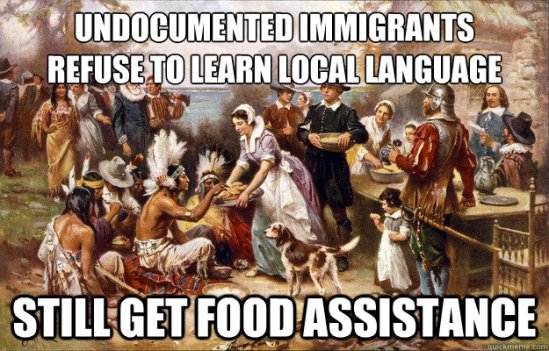
Of course, early American colonists didn’t ask permission from those who already lived there to enter into the country. But nobody seems to talk about that. Could it be that the residents were Native Americans and the colonists were white?
- Undocumented immigration is a new problem.
Did the original colonists ask the Indians permission to settle their lands? I don’t think so. At any rate, it didn’t end well. Besides, in US history after the colonial era, undocumented immigration was most prevalent during the Gilded Age. Today 3.5% the US population are undocumented immigrants which is equivalent to how many Americans own a boat. Nevertheless, undocumented immigration is more of a problem pertaining to a system, not the individuals.
- My ancestors didn’t come here illegally.
Are you sure about that? If you’re of Asian descent and your Asian ancestors came to this country between 1880 and the 1940s, then there’s a very strong chance they came to the US illegally. Mostly because US immigration policy at the time either excluded Asians from entering (save under certain circumstances) or had very small quotas on arrivals from Asian countries. Chinese immigrants used a variety of techniques to enter the country such as changing their names or showing pictures to officials of fake relatives already living there. And even if Asian immigrants managed to enter the country legally, they were still banned from becoming citizens. Basically, the only way for an Asian to have American citizenship at the time was being born there. Also, being European descent doesn’t mean your ancestors came to this country legally either. Because there were plenty who arrived to the US as ship stowaways, used false papers like citizenship documents, hid previous criminal behavior, bribed officials and captains, forged medical records, traveled as first class passengers who were only given cursory examinations.Oh, and there were plenty of Mexicans and other folks from Latin America crossing the border. Besides, it’s very clear that restrictive immigration policies in the US were often used to keep racial and ethnic minorities from entering.
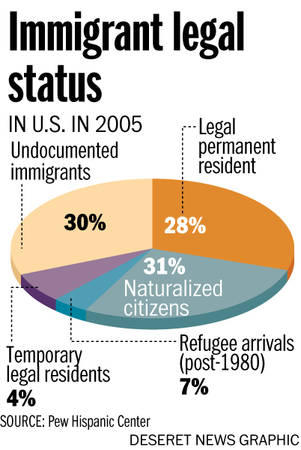
Here is a chart on immigrants from the Pew Hispanic Center in 2005. Note that over half of them are either legal permanent residents or naturalized citizens.
- Most immigrants today are undocumented.
75% of all immigrants in the US are legal. Out of the 25% who are undocumented, 40% of them entered legally but overstayed their temporary (non-immigrant) visas without renewal.
- Most undocumented immigrants are border crossers.
Nearly a third to a half of all undocumented immigrants in the United States today have entered legally but overstayed their visas or failed to renew their green cards. Also, a lot of undocumented immigrants also came to this country by plane or boat.

There’s a group at the US-Mexican border called the Minutmen Militia who are a group off self-appointed and heavily armed border patrollers who are known to threaten and shoot anyone they suspect as an undocumented immigrant trying to get across. Though their numbers have been declining since their heyday in the mid-2000s, they are nativist extremists who deserve to be in prison.
- More US border enforcement will deter undocumented immigration.
More incentives to make it easier for immigrants to renew their visas or pursue paths to permanent residents or citizenship will be more effective. Besides, the border between the US and Mexico is almost 2,000 miles long, spanning difficult terrain that includes deserts and mountains. Add to that much of the area is private property which the government will have to buy from owners if you want to build a wall there. Many don’t want to sell their land. Also, the logistics alone in building Mr. Cheetohead’s wall are either very difficult, if not impossible. Not only that, but history has shown that people find ways to cross walls. The Great Wall of China didn’t deter Mongol invaders nor did the Berlin Wall keep East Germans from fleeing the Eastern Bloc. In the US, should Mr. Angry-Oompah Loompah’s wall be built, experts predict coyotes (human smugglers who charge migrants high rates to cross the border) to dig tunnels and create breaches. This would increase smuggling prices, making such process simply more lucrative for those who merely exploit migrants. And even if that didn’t happen, people will still come to the US wanting to seek better life. Hell, many undocumented immigrants are willing to risk their lives for that, let alone breaking the law and deportation. No wall can deter that.
- Undocumented immigrants don’t want to learn English.
Most immigrants usually learn English within 10 years after arrival and there is a great ESL demand for them that far exceed the supply. Many immigrants also learn some English while on the job, whether they arrived to the country legally or not. But while undocumented children usually learn English in school, most undocumented adults simply don’t have the resources.

Here’s a chart showing the how the rate of naturalizations per year is often outnumbered by the number of petitions for citizenship filed. And this chart pertains to the legal immigrants who can become citizens. As for undocumented immigrants, most of them do want to become citizens since the majority have lived in this country for 10-15 years. It’s just they can’t.
- Undocumented immigrants don’t want to become American citizens.
There are plenty of immigrants who become citizens in which they have to overcome obstacles like getting here, finding a job, language barriers, naturalization fees, a lethargic immigration bureaucracy, and a written citizenship test. These people don’t take becoming American lightly. Currently, 47% of immigrants are naturalized citizens. And let’s just say attaining citizenship isn’t easy since the naturalization process involves untenable wait times, often too few spots, and requiring expensive filing fees. In other words, the US immigration system is an outdated, expensive, and convoluted one which doesn’t help the immigrants seeking citizenship as the proportion has grown significantly. And that’s only for those lucky legal residents. Besides, there are plenty undocumented immigrants who have resided in this country for years, some nearly their whole lives. 86% of undocumented immigrants have been in the country since 2005 (while a third have lived there for 15+ years). Nearly half of them are parents of minor children while 2 million came to the country as children. So if these people aren’t citizens it’s not a matter of wanting to because most of them clearly want to stay in the country. It’s just that their immigration status doesn’t allow them. Because it’s very likely that most of these people would’ve taken advantage of that opportunity by now.
- Undocumented immigrants are a drain on our economy.
Most undocumented immigrants who enter the country are of prime working age and they work pretty shitty jobs. Not to mention, the only impact undocumented immigrants have on wages would be in firms that hire them as well as their documented counterparts (as well as the unscrupulous employers who hire them). There are some undocumented immigrants who even start businesses and create jobs that wouldn’t exist without them. We also forget the fact that undocumented immigrants are consumers who buy stuff in American stores that also contributes to the economy.
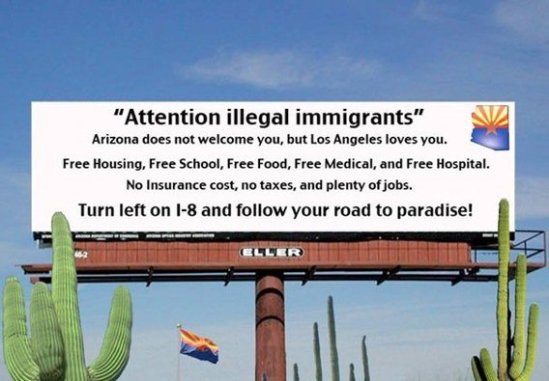
This billboard from Arizona tends to also spread a lot of misinformation about undocumented immigrants. Contrary to this, most undocumented immigrants pay taxes and are ineligible for most government programs. Whoever erected this Arizona billboard is a complete tool.
- Undocumented immigrants don’t pay taxes but still get benefits such as education for their children.
Yes, there are undocumented immigrant children who do attend public schools as well as US citizen children with undocumented parents. However, undocumented immigrants do spend money in this country and most states have sales taxes. Also, many have property taxes as well whenever they rent or buy a house or apartment. And since many might need transportation for a job, many pay excise taxes when they stop for gas. In fact, the Social Security estimates that half to 3 quarters of undocumented immigrants pay federal, state, and local taxes, a lot of which go to benefits they’ll never receive. Besides, most undocumented immigrants work for employers who either don’t know they’re undocumented or don’t want to know. For instance, employers in 2009, reported paying $72.8 billion in wages to 7 million workers without legitimate Social Security numbers. Undocumented immigrants can send their children to school or receive medical care in the ER as well as public health immunizations. But since they lack essential documents, they aren’t eligible for welfare, Medicaid, Medicare, Social Security, public housing, or food stamps. And many don’t even seek them even if their children are eligible (because you know, fear of deportation). So it’s very unlikely that they’re receiving benefits at the taxpayers’ expense (though people might have to pay for their care in the ER through their insurance since they’re a lot more likely to be uninsured and ineligible for government medical benefits. Even so, they use disproportionately less medical services and contribute less to healthcare costs). Hell, there are some programs not even lawful immigrants are eligible for until they’ve been in the country for at least 5 years. Thus, it’s more likely, that undocumented immigrants pay more in taxes than they receive in benefits which many can’t even access like $80,000 more. Hell, it’s even estimated that giving all these undocumented immigrants a clear path to citizenship, tax revenues could increase by $845 million a year once fully in place just at state and local levels. Give them higher wages and ability to file income taxes like the rest of us and their net tax contribution can go up to $2.2 billion in addition to the $11 billion they already pay.

And here’s a graph on how much undocumented immigrants pay in state and local taxes. these include income, property, sales, and excise. Many of these will go to programs that will never benefit them. So even though undocumented immigrants aren’t living here legally, they’re not living here for free.
- Most undocumented immigrants are Latino.
This might be true when it comes to those crossing the border into Texas. However, there are plenty of immigrants who aren’t out of those who’ve overstayed their visas.And they come from all over the world, particularly Asia. Besides, Asian undocumented immigrants are on the rise.

For a time there was a movement among Republicans for getting rid of birthright citizenship as well as the insidious notion of “anchor babies,” which has no basis in reality. Because it’s been well known that just because undocumented immigrants have US citizen children, doesn’t mean they’re less likely to be deported. Because 5,100 American children are in foster care because their parents were either deported or at some immigration detention center. Deportation tears families apart.
- “Anchor babies” keep their parents in the United States.
Today nearly 5 million undocumented immigrants are in families with minor children. Only 1 million of these minor children in undocumented families are undocumented themselves while 4.5. million of them are native born US citizen. This comprises of 9 million people living in mixed status families, often with one undocumented parent and at least one child born in the US. However, there have been 108,000 parents of US born citizens who were deported over the last decade. Thus, being a parent of a native born citizen doesn’t guarantee them any right to stay in the US. Besides, in order for the “anchor baby” scheme to work, the child in question must turn 21 before they can sponsor a parent for legal entry in the US using form I-130. So this would mean that undocumented immigrants would have to stay for 21 years before their “anchor baby” could keep them in the country. This assuming that they return to their home country and not personally raise their child for 10 years. And unlawful entry usually result in deportation as well as 3-10 year bars to eventually a permanent bar. So it’s not a practical solution. Most undocumented immigrants tend to be deported earlier whether their kids are American citizens or not. The fact undocumented parents of US citizens can still be deported for their immigration status is a very serious problem (if not, then outright cruel since it tears families apart). Nevertheless, despite what Mr. Hamsterhair and fellow Republicans might say, I would never advocate that the US do away with birthright citizenship because it’s a wonderful thing (as well as the rest of the Fourteenth Amendment I might add). So, yes, I do think having a child who’s a US citizen should allow their undocumented immigrant parents to stay because keeping families together is the right thing to do. It’s especially the case for infant children and their mothers or children with single parents. Unfortunately, “anchor babies” don’t prevent deportation much.

Though Republicans like to think that undocumented immigrants come to the US to have “anchor babies,” most of them come to this country for the same reasons as their legal counterparts. In this graph on undocumented Latinos, the two biggest reasons are for better jobs and opportunities and better life for family and children.
- Most undocumented immigrants come to this country to have “anchor babies.”
While birthright citizenship is a wonderful thing, having an American child has no effect on a foreign parent’s immigration status whether undocumented or not. Research consistently shows that immigrants mostly come to the US for economic opportunity, build a better life for their families and kids, as well as flee violence, persecution, or poverty. Immigration trends tend to be consistent with US economic activity. Besides, if people were coming to the US to solely have children, we’d expect to see the same number of women as men. But research has shown that there are many more young men coming to the US than young women. Then there’s the fact that undocumented immigrants do not personally receive any legal benefits whatsoever for having children on American soil. In fact, they’re just as prone to deportation as any undocumented immigrants who don’t. Need proof? Ask the 5,100 American children currently in foster care because their undocumented parents had no access to adjust to a legal immigration status so they could stay in the country as well as were unlucky enough for law enforcement to find out about it. Thus, they’ve either been detained or deported.
- Undocumented immigrants are criminals because they didn’t enter the country through the proper legal channels.
Under federal law, undocumented immigrants aren’t considered criminals because undocumented immigration is a civil offense and tried in civil courts. The punishment is usually deportation and ban on reentry. Criminals violate serious laws and are tried in criminal courts, which usually results in imprisonment. Besides, most undocumented immigrants tend to have very legitimate reasons for not entering the country through proper legal channels. Mostly because they were simply not available to them in the first place (because the US only distributes 5,000 visas to low-skill workers each year and there’s a 4.4 million people line for that green card lottery, many who’ve waited for years or even decades). And that obtaining legal status or citizenship is impossible for them. Add to that the fear that many fear deportation as well as what would happen to their US citizen children if they’re not around. If an undocumented immigrant chose to enter the country illegally, it was mainly because illegal entry was their only viable option while the legal alternatives simply didn’t exist.
- There are more undocumented immigrants in the US than ever before.
There were more undocumented immigrants in the US during the Gilded Age mainly due to a large foreign born population as well as racist immigration quotas that severely restricted certain groups from entering, particularly East Asians.
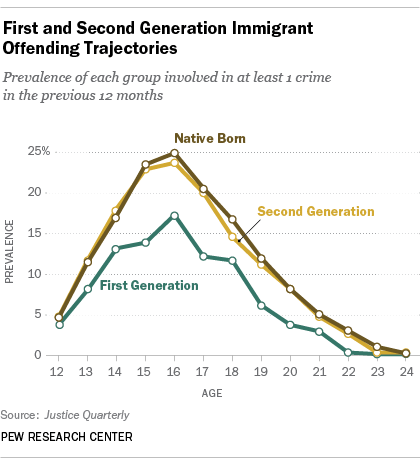
Those who are against immigration reform, often say that undocumented immigrants bring crime or are criminals. Studies have shown that immigrants are less likely to commit crimes than their native born children and other citizens, regardless of legal status. Because the realistic possibility of getting deported or obtaining citizenship brings a very high incentive to obey the law.
- Undocumented immigrants bring crime.
They are more likely to become victims of crimes that never get prosecuted since their undocumented status makes them especially vulnerable. After all, they’re 70% less likely to call police to report themselves as victims because they’re unwilling to risk deportation. And they’re right to fear that since 240,000 undocumented immigrants with zero prior convictions have been deported under the Obama administration compared to 200,000 who did. Still, most crime statistics over the last 70 years would point out that immigrants have lower incarceration rates than native born Americans even for the most minor offenses. Legal immigrants know that even committing the most minor offenses might can count against them when they’re going through the naturalization process. The criminality rate among immigrant families increases with each generation born in the US. So instead of bringing criminality to this country, they tend to grow into it as they become more American. Not to mention, it says a lot that 3 out of 4 people caught bringing drugs across the border are US citizens. As immigration has risen, crime rates have declined even in the poorest neighborhoods. Undocumented immigrants are usually sent through the deportation process if they’re arrested. Thus, they have a very high incentive not to break the law.
- Undocumented immigrants take good jobs away from Americans.
Most undocumented immigrants usually take jobs Americans don’t want like in the low-income service industry. This thanks to better education and an aging population that most native-born Americans prefer to take jobs in management, professional, sales, and office occupations. And many undocumented immigrants take certain service and menial labor jobs because they don’t have the skills or education or there are no better jobs available (I’m talking general trends but some do become managers). Nevertheless, undocumented immigrants are very prone to exploitation by unscrupulous employers and are more likely to be paid below minimum wage. They’re also prone to occupational hazards and less likely to receive benefits. Also take account they are much more likely to have their wages stolen by their employers. Still, undocumented immigrants don’t compete for the same jobs as native born Americans even in the low-income sector (like service occupations where you’ll have to be present for the customers like at a restaurant or a store). It’s also often said native born and undocumented workers tend to possess different skills that complement one another. Some may even start businesses and even create jobs that wouldn’t exist without them. We should also be aware that undocumented immigrants buy stuff in this country as consumers which also creates jobs. Besides, there are no negative effects of immigration on most native workers’ wages anyway (because negative effects on wages have more to do with greedy employers than anything).
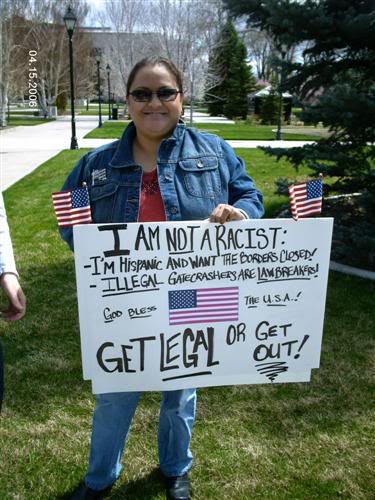
Too many people like this idiot protester tend to believe that undocumented immigrants could’ve simply entered the US legally. Unfortunately, unless they’re willing to wait decades for authorization or get extremely lucky with the 5,000 low-skill worker green card lottery, most poor immigrants don’t have any legal options. Also, no programs exist for undocumented immigrants to obtain a legal status, let alone citizenship. If there was, then they’d certainly take advantage of it.
- There’s a way to enter the country legally for anyone who wants to get in.
Most poor people who enter have few skills to stand in and gain permanent US residency. So there’s no “line” for them. This is because gaining permission to stay in the US is limited to people who are highly trained in a skill that is in short supply here and were offered a job by a US employer, escaping political persecution, joining close family already here, or got lucky in the green card lottery (that only has 5,000 slots for low skill workers). I’m sure “anchor babies” and green card marriages aren’t desirable strategies either. While the US had an open immigration system for its first 100 years, many citizens’ immigrant ancestors arrived between 1790 and 1924 wouldn’t even be allowed to enter in today under the current policy (or even under policy then but plenty got in, anyway like Asians who were mostly low-skilled workers as well). There are many rules about who can enter the country and stay legally. Also according to the State Department, that imaginary “immigration line” is already 4.4 million people long and depending on the type of visa sought, the wait can be for years to decades long. In some countries such as the Philippines and Mexico, people have been waiting for 20 years for approval of a family-sponsored visa (which usually takes about 5-6 years). In many poor, violence ridden countries, or where parents are separated from their children, immigrants say the wait is unbearable, leaving many to resort to illegal border crossings. The journey can be dangerous. Not to mention, the US currently has no program whatsoever for undocumented immigrants to adjust to a legal status, let alone citizenship. Most of these people want nothing more than play by the rules and legalize their status but most of them have no legal way to enter or remain in the US. This is wrong, especially when we’re talking about undocumented parents with American born children.
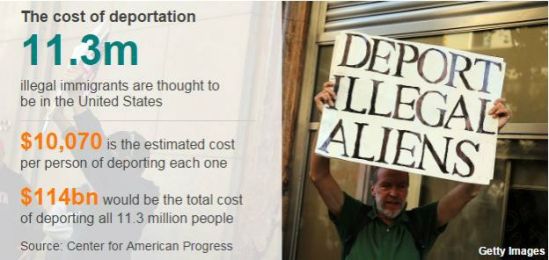
To deport undocumented immigrants is not just impractical and economical, it’s also downright cruel. All that deportation will accomplish will be families torn apart, more American children in foster care and utterly traumatized, lost jobs, wasted tax money, and an overall humanitarian crisis.
- Undocumented immigrants can and should be deported from the United States.
If we got rid of all the undocumented immigrants in this country, it would be a real government and social nightmare. For one, there are approximately 11 million undocumented immigrants in the US and it would be impossible to locate and deport that many people. Then there’s the fact that they have an estimated 4.5 million children born on US soil whom the government would have to put in foster homes. Hell, at least 5,100 native born kids are in foster care now because their parents have been detained or deported. Deportation will often result in family separation which will pose serious risks to children’s immediate safety, economic security, well-being, and long-term development. Other effects include housing instability, food hardship, and adverse behavioral changes. That’s not talking about the citizen children being traumatized and vulnerable by the whole experience along with entire communities (who may also have undocumented immigrants and their US citizen children living there, too). Not to mention, it’s unlikely that native born Americans would want to do the lousy back-breaking agricultural work and other menial labor for minimum wage and no benefits that undocumented immigrants do which is said to be at 50 to 60%. Then there’s the fact mass deportation would lead to remove millions of taxpayers, consumers, and entrepreneurs as well as cost jobs in the economy.

Here’s a cartoon of the Holy Family being besieged by ICE feds in the stable. Undocumented immigrant families fear deportation and family separation on a daily basis. The fact deportation rips families apart should illustrate why such a practice is morally inexcuseable.
- Denying undocumented immigrants from obtaining a drivers’ license will solve the problem.
Almost all American workers need to drive great distances to get to work, and undocumented workers are no exception, especially if they work on a farm. Some even drive for a living. Most US citizens would agree that everyone driving on the highways should complete a driver’s course to qualify for a driver’s license would be better for public safety. Thus, not worth it.
- Our undocumented immigration problems would be solved if employers were required to verify the Social Security Numbers for every employee.
It could but only as long as there’s a legalization program put in place at the same time which the US doesn’t have at the moment. Thus, such a policy would create chaos in multiple sectors of the US economy, especially in the agricultural industry complex. The tourist industry would suffer as well since many undocumented immigrants are employed in low skills jobs like dishwashers, janitors, chambermaids, and others.
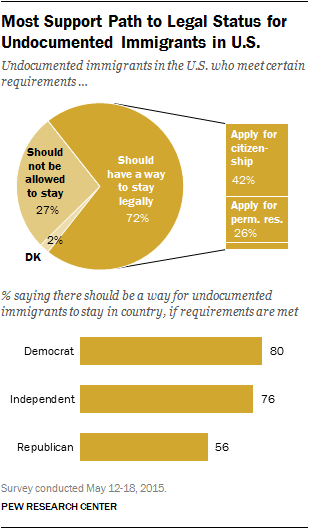
While comprehensive immigration reform may be a highly contentious issue that brings out a lot of racism, nativism, and xenaphobia, most Americans support it. According to pew 72% of Americans want undocumented immigrants to remain in the country with some legal status.
- Most Americans don’t support immigration reform.
Newsflash: most do, particularly when it comes to allowing undocumented immigrants to obtain legal status so long as they have a strong work history, don’t commit any crimes or get deported, pay taxes, learn some English, and pay fines. Because if an undocumented immigrant has lived in the US for at least 10-15 years, has a steady job, paid taxes, raised American children, observe the law, and minded their own business, then they should be able to remain in the country.

Those who believe that immigration restrictions will lead to a secure society have no idea of how law enforcement depends on its relationship with the community. And most police don’t want undocumented immigrants to fear deportation. Besides, history has shown that restrictions don’t deter undocumented immigration. However, Metropolis’s safety is a toss up.
- Restrictions to undocumented immigration will lead to a secure society.
Enforcing laws make it difficult for undocumented immigrants to contact law enforcement which can have an adverse effect on overall security in society. If immigrants fear deportation, then they’re less likely to report on criminal activities, which can interfere with creating a safe community. This is why many local areas have sanctuary cities since protecting law-abiding undocumented immigrants from deportation does keep people safe. Not only that, but rigid limits on legal entry have already fueled undocumented immigration as we speak (such as East Asian immigrants during the Gilded Age).

Green card marriage fraud is another allegation Republicans make when pertaining to undocumented immigrants. However, since the US government and Homeland Security have been familiar with green card marriages being one of the easiest ways for foreigners to remain in the country, this is not a viable option. By the way, this is from a movie called Green Card from the 1980s starring Gerard Depardieu and Andie McDowell.
- Undocumented immigrants tend to gain citizenship through marriage fraud.
For one, there are a lot of undocumented immigrants who are already married and thus ineligible or unwilling to commit to an American citizen for a green card. Secondly, the US has been quite successful in deterring this for quite some time which usually result in offenders being caught and convicted with heavy penalties like deportation. Homeland Security is a pro at detecting these so most undocumented immigrants won’t even try it. And even if an undocumented immigrant does have an American spouse, this may not mean they’re safe from deportation. Or not without a tedious process that could possibly take years (despite it being in an easier position to get a green card than most undocumented immigrants). Because a lot of undocumented immigrants with American spouses do face threats of deportation even if both partners are living together.
- Undocumented immigrants bring diseases into the US.
Well, this was certainly true in this country’s colonial period since we know what happened to the Native Americans. However, although people claimed that undocumented immigrants have brought diseases to the US including measles, hepatitis C, HIV, tuberculosis, and even ebola, these claims aren’t supported by science or medicine. There is no evidence that immigrants have been the source of modern outbreaks in the US since 113 countries, including many in Latin America have higher vaccination rates for 1 year olds. Mexico has a 99% vaccination rate for measles while Guatemala, El Salvador, and Honduras have around a 93% vaccination rate. US vaccination rate is about 92%.
- Terrorists are infiltrating the US by coming across the Mexican border.
There’s no evidence that terrorists are entering the US through the Mexican border. According to the Department of Homeland Security, “the suggestion that individuals that have ties to ISIL have been apprehended at the southwest border is categorically false, and not supported by any credible intelligence or facts on the ground.” In 2015, the US Department of State, Bureau of Counterterrorism added, “there are no known international terrorist organizations operating in Mexico, despite several erroneous reports to the contrary during 2014.” In fact, the vast majority of US residents linked to terror since 2002 are US citizens. Also, those 9/11 hijackers came to the US through legal means and not through crossing the Mexican border either.

While there are undocumented immigrant children in American schools, they only make a small percentage of US schoolchildren. And they only constitute a minority of kids who are children of undocumented parents.
- US schools are overflowing with undocumented immigrants.
About 7% of all K-12 students in the US had at least one undocumented immigrant parent in according to Pew in 2012. Of these students 79% were born in the US, making them US citizens. So undocumented immigrant children are a very small segment of that population enrolled in American schools. Those with the largest shares of children with at least one undocumented immigrant parent are Nevada (18%), California (13%), Texas (13%), and Arizona (11%), all of which have less than 20%.

Along with saying that undocumented immigrants bring crime, many anti-immigration folks claim that sanctuary cities are criminal hellholes that protect the guilty. In reality, they’re anything but because a lot of sanctuary cities’ staunchest defenders are local and state law enforcement. This is mostly because sanctuary citizens protect undocumented immigrants from deportation as long as they don’t commit any crimes. Such practice allows police to build relationships with more immigrant residents as well as improve their ability to fight crime. Unfortunately, sanctuary cities aren’t very popular among the general public.
- Sanctuary cities are criminal hellholes.
Now sanctuary cities are places where officials have explicitly or implicitly said they won’t prosecute undocumented residents solely because of their immigration status or if they would otherwise qualify for release. Most sanctuary cities tend operate on a “don’t ask, don’t tell,” basis. Meaning that law enforcement and municipal officials can’t inquire on an individual’s immigration status and can’t share such information with Immigration and Customs Enforcement (ICE). So long as the undocumented immigrant in question minds their own business and doesn’t commit any crimes. Such policies could be in ordinances, laws, resolution, or law enforcement directive. But this doesn’t necessarily mean that these areas won’t cooperate with Homeland Security completely. Because that’s not necessarily the case. There are over 300 of such places in the US. However, what you may not know is that sanctuary city measures became law in these areas thanks to community activists and local law enforcement efforts. Why? Well, because not checking whether a person is undocumented actually makes it easier for police to do their job and helps deter crime since undocumented immigrants don’t have to worry about being deported if they report anything to the police or over a speeding ticket. Because deportation fears are the main reason why undocumented immigrants in the US are 70% less likely to report themselves as victims when something terrible happens. Such fears make it harder for law enforcement to keep their cities safe because it prevents detectives from having access to potential victims, witnesses, snitches, or neighborhood advocates. Not having that access might keep local law enforcement from catching criminals and putting them in jail, particularly since undocumented immigrants tend to be particularly vulnerable in becoming crime victims. Sanctuary city policies have allowed police build bridges with immigrant communities, earn trust from immigrant residents, and improved their ability to fight crime and protect the entire community from harm. They also spare taxpayers from the expense of arresting and holding people the feds are in no hurry to deport. The federal government isn’t a fan of sanctuary cities (since they might be illegal) and public opinion isn’t very high. Many Republicans would want to see these places punished and denied crime-fighting federal funding. But contrary to popular belief, sanctuary cities aren’t nearly the criminal hellholes anti-immigration politicians make them out to be and it’s wrong to punish them. Besides, the federal government isn’t giving sanctuary to the undocumented immigrants who clearly should have a right to stay.
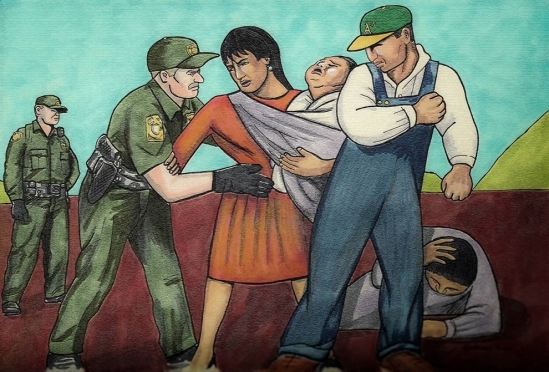
If there’s a reason why we should leave sanctuary cities, it is because they provide mercy for a group of people whose very presence makes them susceptible to deportation. And these are people who have families as well as built their lives in this country. Besides, deportation tears families apart and is morally unconscionable. I’m sorry, but it’s just cruel.
- Immigration reform is another form of amnesty.
If immigration reform includes a pathway to citizenship for the 11 million undocumented immigrants already living here, it will be a rigorous path. Under the Senate’s proposed Border Security, Economic Opportunity, and Immigration Modernization Act of 2013, they would have to wait 10 years for a chance at permanent residency and 3 more for citizenship. On top of that they’d have to pay $2,000 in fines along with hundreds of dollars in fees and taxes. Not to mention, they’d also be required to learn English, pass criminal background checks, as well as prove to have lived continuously in the US and have been regularly employed during this time. Not exactly a free ride, but it gives more undocumented immigrants a way to become citizens than the current system. Also, what the hell is wrong with amnesty anyway? (Nothing).

Arizona’s S.B. 1070 is a notorious example of anti-immigration policy at its worse. Not only does it make police officers immigration agents (which police don’t want), it also encourages racial profiling which make even Hispanics squirm regardless of legal status.
- An immigration law like in Arizona will solve our immigration situation.
No, it will not. For those who don’t know, there’s this law in Arizona in which requires police to determine the immigration status of someone arrested or detained when there’s a “reasonable suspicion” they aren’t in the US legally. Its passage in 2010 sparked many angry protests across the country until local and federal courts overturned parts of it. Mostly because it encourages racial profiling on Hispanics. That law in Arizona is an overreaction that can be best compared to 1942 Japanese internment camp policy. Besides at least 30% of Arizona’s citizens are Hispanic and legal. The Arizona law is vague and only invites discrimination against them. Arizona’s police chiefs opposed the measure because most police don’t want to identify non-criminal undocumented immigrants for deportation and don’t want to be seen as immigration agents. Mostly because they believe doing so would make it harder to build for them to earn the immigrant residents’ trust as well as protect the community. Treating undocumented immigrants like criminals is not the answer.
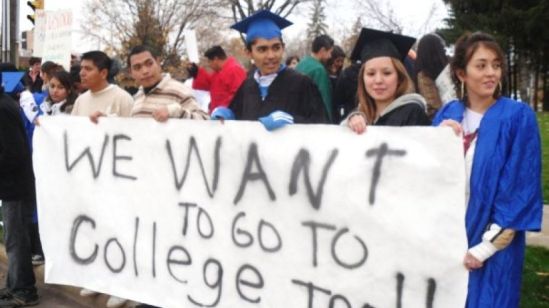
This is a group of undocumented students demonstrating for the opportunity for a college education. These kids particularly have a hard time being able to do so because their immigration status makes them legally ineligible for the financial aid their legal counterparts take for granted. And even if they do graduate and/or go on for advanced degrees, they are legally barred from entering any profession that requires a license.
- Undocumented students have the same opportunities as their documented peers.
Sorry, but this isn’t true at all. Aside from the usual socioeconomics, fears of deportation, and ineligibility for social services, undocumented students don’t have the same opportunities as their documented peers at all. While most children of undocumented immigrants don’t graduate from high school, not all of them have the same opportunities. Of course, economics certainly plays a critical role here since most undocumented immigrants are poor and it’s certainly a reason why many of their children don’t finish high school. And I’m very aware that many of these kids who do graduate may not be college material. However, the difference becomes very apparent when pertains to children of undocumented immigrants who do graduate and are college eligible. Those who were born in the US will have access to a college education as well as all the rights they’re guaranteed as citizens. Those who weren’t, will have to face legal barriers that deny them the resources and opportunities necessary that might make a college education virtually inaccessible. Undocumented students can’t legally receive any federal funded student financial aid including loans, grants, scholarships, or work-study money (because undocumented immigrants are barred from receiving any grants and loans under federal law). Only 5 states allow instate tuition for undocumented students while most private grants, scholarships, and loans require either citizenship or permanent resident status (which they can’t get). Many of them will denied a college education because they’ll simply be unable to afford it without the financial aid they need but can’t have. Even if these undocumented students do graduate from college (or receive other vocational training), they may not be able enter certain career paths because they’re barred from receiving a professional license under federal law. This means undocumented immigrants legally can’t be doctors, lawyers, accountants, pharmacists, engineers, architects, nurses, land surveyors, cosmetologists, building contractors, therapists, electricians, and others. Sometimes this can vary by state law but it’s said that 30% of American workers need licenses to do their jobs. Thus, 30% of Americans workers are in careers that undocumented immigrants can’t pursue. To deny an undocumented child an education or other benefits and opportunities is simply discriminatory. Most of these kids didn’t choose to come here and some grew up perhaps unaware of their immigration status for most of their lives. Some may not discover their status until they’re much older. One of the reasons for the DACA and Dream Act under Obama was so most undocumented immigrant students can have legal status as well as legal access to an education all through college. Now with the Supreme Court being impasse on Obama’s immigration policy, so many undocumented children might be in limbo.
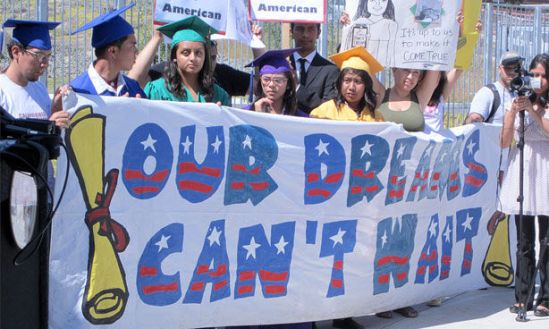
Here is another group of undocumented students who are demonstrating in support of the DREAM Act. Because they don’t have the kind of opportunities as their legal counterparts and it’s a real shame. After all, these students came to the US as children and are legally barred from certain opportunities due to extenuating circumstances. This isn’t right.
- Undocumented immigrants are lazy.
96% of undocumented immigrants are employed, exceeding the labor force participation rate of their legal counterparts as well as US citizens. Many work 2 or more jobs. Besides, it’s clear that employment is a driving force behind undocumented immigration with many industries such as restaurants, hotels, and agriculture reporting a reliance on them. Thus, most undocumented immigrants came to this country to provide for themselves and their families.
- Undocumented immigrants don’t contribute anything to society.
Uh, since most undocumented immigrants are employed, most of them also pay taxes as well as goods and services. Some of them even end up starting their own businesses. Many even pay rent or have their own homes. So to say that undocumented immigrants don’t contribute anything to society is absurd.
- Undocumented immigrants bring down wages.
Only in low-skill and low-wage jobs and this minimal. But this is mostly because they lack legal status. Undocumented workers are exploited as well as constantly threatened with the possibility of deportation. Thus, they’re often forced to put up with low pay and poor conditions as well as be most prone to wage theft (in which employers fail to pay them what’s rightfully owed). Most studies show that legalization would raise wages in these types of jobs, because workers can organize for better pay and employers cannot scare immigrants into accepting a poor deal. At least at a general legal level (because US businesses can still ban workers from joining a union like Wal Mart, unfortunately). Nevertheless, undocumented immigrants don’t bring down wages, their unscrupulous employers do.

Here is an infographic showing the economic impact of comprehensive immigration reform. By granting undocumented immigrants a path to legalization and citizenship, more jobs would be created while incomes and revenues would increase across the war.
- Comprehensive immigration reform that includes a pathway to citizenship for undocumented workers would hurt the economy.
Comprehensive immigration reform including a pathway to citizenship for undocumented workers could yield at least $1.5 trillion US GDP in over 10 years. Because eliminating the undocumented underclass workers that employees use to undercut wages and drive down standards, comprehensive immigration reform will ensure that all workers have full labor rights, resulting in higher wages across the board.

This Princeton pamphlet for undocumented immigrants points out that these people have the right to remain silent, right to legal representation, and a right to make a call when they’re arrested. Their children also have a right to a free K-12 education as well.
- Undocumented immigrants are without rights in the United States.
Undocumented immigrants do have rights in the US under the US Constitution and federal statutes such as equal protection under the law (even non-citizens) and can’t be denied due process under the 14th Amendment including the right to remain silent and the right to an attorney as well as the right to be protected against unwarranted searches and seizures under the 4th Amendment. Undocumented children also have the right to a free, public K-12 education. Undocumented immigrants also have a right to receive emergency services from publicly funded hospitals, protection from workplace discrimination, emergency and disaster relief, and others.
- Employers may easily and accurately determine whether an immigrant is adequately documented.
According to US Chamber of Commerce Vice President Randel K. Johnson, “The current system has made it impossible for employers to really know who is actually authorized to work and who is not.” It is possible for employers to hire undocumented immigrants unintentionally which might happen when they present falsified documentation or when an employer fails to verify their work eligibility. Yet, since 1986, all employers have to verify identity and work eligibility for all new employees at the time they’re hired by filling out an I-9 verification form. Many employers are unaware or do it poorly or incorrectly. Completing this form requires skills and knowledge: there’s a list of acceptable documents and many exceptions, it’s difficult to know if a document is genuine, acceptable, or still valid. Moreover, employers face penalties for discriminating against well-documented immigrants even if their intention was to avoid hiring undocumented ones. In addition, the US immigration system doesn’t meet the needs of American business who must face lengthy delays before hiring foreign workers. Not only that, but there are many employers who hire undocumented workers and know it but either don’t care or use their status to exploit them.
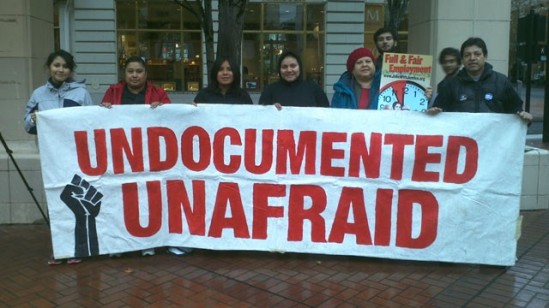
The idea that undocumented immigrants prefer to remain in the US illegally have no idea that these people have no realistic alternative for legal entry. If any undocumented immigrants had any option to enter legally, they would take it.
- Undocumented immigrants prefer to remain in the US illegally.
Undocumented immigrants who face economic hardship, life threatening situations, or persecution believe they have no reasonable alternative to becoming undocumented either because they don’t meet the strict criteria to immigrate to the US or because they can’t afford to wait 10, 15, or 20 years to obtain a visa. Some legal immigrants who become undocumented due to visa overstays even after applying for a visa extension are only due to government processing delays. Not to mention, some undocumented immigrants are brought to the US as children and at times, grow up here not knowing of their immigration status. They have absolutely no path to become legal residents without facing as much as a 10 year ban as well as deportation despite extenuating circumstances. Then there are undocumented immigrants who have spouses and children who are US citizens. Would you say these people prefer to stay undocumented and risk being taken away from their families? Nearly all undocumented immigrants would legalize their status if they had the opportunity.

This is a rough graph of undocumented immigrants living in the US. Most of them live in just 6 states and only make a small fraction of the labor force. Children of undocumented immigrants only make 7% of the school population.
- Undocumented immigrants are mostly single men.
Over 40% of undocumented immigrants are women and most undocumented men are either married or in families (54%). Fewer than half of undocumented immigrants are unattached and single men. There are also 267,000 undocumented immigrants who are part of the LGBT community, too.
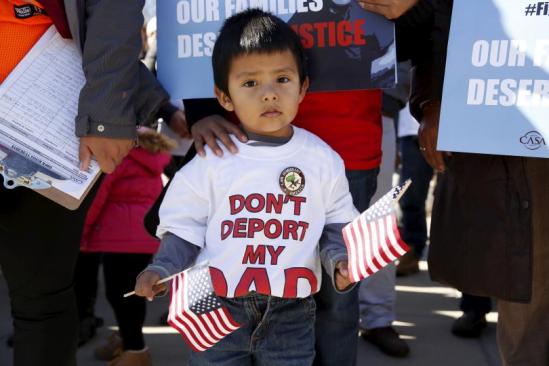
While many Republicans say that most undocumented immigrant children are unauthorized, most of them are US citizens. And many of them have hard lives. This little boy is a US citizen who has to worry about the possibility of his dad being deported. If you think undocumented immigrants should be deported, then explain to him why such immigration policy should deny him a father in his life. You can’t.
- Most children of undocumented immigrants are unauthorized.
While undocumented children do exist, most children of undocumented immigrants are native born US citizens and members of mixed-status families. Nevertheless, these American children don’t have a great quality of life and are set up for failure. The majority of these kids don’t graduate from high school, averaging 2 fewer years than those with legal immigrant parents. Reasons for this are said to be stress, pressure to work at a younger age, poverty, and not having the economic resources needed for a higher education. They also are more likely to experience linguistic isolation, have limited English proficiency, have poor health outcomes, be uninsured, and are less likely to be enrolled in preschool. Nearly half are in households where no member over the age of 14 speaks English very well. For many of these children, their undocumented parents and relatives may be their main caretakers as well as their only means of support. If they’re aware of their parents’ immigration status, they may grow up living in fear that their someone will come in and take their parents away from them. And they live with such fears every day in their lives. 5,100 US children are now in foster care because they had nowhere else to go after ICE got a hold of their parents. While immigration reform that gives these children’s undocumented parents a path to legal status and citizenship won’t solve all their problems, it will at least give them some stability in their lives.

Caption: “Estrella Manuel, 2, holds an American flag in her mouth during a news conference in Miami Wednesday, June 17, 2009. Roughly 150 children are suing President Barack Obama to halt the deportations of their parents until Congress overhauls U.S. immigration laws. The U.S.-born children say their constitutional rights are being violated because they, too, will likely have to leave the country if their parents are forced to leave.” Unless the US passes comprehensive immigration reform that gives undocumented immigrants a path to legalization and citizenship, these children will be condemned to live on the margins of prosperity, opportunity, and hope. Some of them also run the risk of having their parents taken away from them and possibly ending up in foster care. This is wrong.
- The US immigration system works and immigration laws are just.
Such notions like, “But they came here illegally!” assume the system works when the US immigration system hasn’t been reformed in decades to meet our country’s real needs as families, businesses, and workers. When you have laws that don’t match the reality, you have to change them. Besides, a lot of the immigration laws we have now don’t make any sense and our immigration system is broken since it keeps families apart, only 5,000 low-skilled visas are issued a year when there’s a 400,000 low-skilled job demand, and if they wish to enter legally, then they have to wait in line behind people that have been waiting in the legal backlog for years. Would you say a system is just by denying countless people a right to stay in a country where they lived for decades, raised their children, obeyed the laws, paid their taxes, and just minded their own business? Would you say a system is just when it denies children the right to pursue a college education or pursue careers that require a professional license only due to extenuating circumstances? Would you say a system is just when it denies children certain rights they feel entitled to have in the only country they know such as the right to stay without fearing deportation? Would you say a system is just when 11 million people in this country have no way to pursue a path to legalization, let alone citizenship? Would you say a system is just which has torn families apart as well as put 5,100 children in foster care? Would you say a system is just when it makes legal entry for millions of people almost impossible? If you say yes to any of these questions, you must be a xenophobic racist, living in the white affluent bubble of delusion, or both. Because the US immigration system simply doesn’t work.

This is a girl with a cross saying no more deportations and an American flag. Whether she’s undocumented or a native born US citizen of undocumented parents should be of no concern to you. But the fact her life would be drastically improved if undocumented immigrants had access to legalization and citizenship should. Please, we don’t need any more families being torn apart by deportation.






































